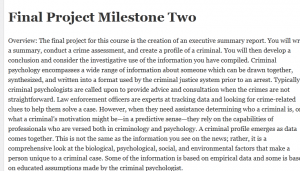Final Project Milestone Two

Overview: The final project for this course is the creation of an executive summary report. You will write a summary, conduct a crime assessment, and create a profile of a criminal. You will then develop a conclusion and consider the investigative use of the information you have compiled. Criminal psychology encompasses a wide range of information about someone which can be drawn together, synthesized, and written into a format used by the criminal justice system prior to an arrest. Typically, criminal psychologists are called upon to provide advice and consultation when the crimes are not straightforward. Law enforcement officers are experts at tracking data and looking for crime‐related clues to help them solve a case. However, when they need assistance determining who a criminal is, or what a criminal’s motivation might be—in a predictive sense—they rely on the capabilities of professionals who are versed both in criminology and psychology. A criminal profile emerges as data comes together. This is not the same as the information you see on the news; rather, it is a comprehensive look at the biological, psychological, social, and environmental factors that make a person unique to a criminal case. Some of the information is based on empirical data and some is based on educated assumptions made by the criminal psychologist.
In this executive summary report, you will look at a variety of factors and work to answer the question “who is this person?” You will examine criminal statistics, lifestyle, upbringing, medical and mental health information, along with a range of other information, that will help you answer the “who, what, when, where, and why” of your chosen case. It will be your job to draw from your previous education and training to learn how to understand what information is relevant to your case. There is no piece of information that is too small to help you build the mosaic of how past activity can help predict future activity. Your profile will be thorough, addressing all of the areas and questions above for the aim of assisting investigators to understand the criminal and his or her motivations and motives as well as the risk of the criminal activity continuing in the future. Through prompts and independent research outside of the text, you’ll peer into the world of investigative profiling.
For this Milestone Two task, you will complete a draft of the profile portion of the final project assessment.
Specifically, the following critical elements must be addressed:
III. Profile A. Develop a demographic summary of the individual based on analysis of data from the case. B. Explain the impact that biological factors of the case had on the individual’s behavior C. Explain the impact that developmental factors of the case had on the individual’s behavior. D. Explain the impact that environmental factors of the case had on the individual’s behavior. E. Apply theories to the emerging hypothesis of the motivation of your chosen subject. In your response, consider the biological, psychological,
social, and criminal violence theories.
Rubric Guidelines for Submission: Your paper must be submitted as a 2‐ to 3‐page Microsoft Word document with double spacing, 12‐point Times New Roman font, one‐inch margins, and at least three sources cited in APA format.
Critical Elements Exemplary (100%) Proficient (85%) Needs Improvement (55%) Not Evident (0%) Value
Profile: Demographic Summary
Meets “Proficient” criteria and response demonstrates an exceptionally detailed summary
Develops a demographic summary of the individual based on analysis of data from the case
Develops a demographic summary of the individual based on analysis of data from the case but the demographic summary of the individual is cursory or lacks detail
Does not analyze data from the case to develop a demographic summary of the individual
18
Profile: Biological Factors
Meets “Proficient” criteria and response demonstrates an insightful ability to assess the impact of biological factors
Explains the impact that biological factors of the case had on the individual’s behavior
Explains the impact that biological factors of the case had on the individual’s behavior but explanation lacks sufficient detail
Does not explain the impact that biological factors of the case had on the individual’s behavior
18
Profile: Developmental
Factors
Meets “Proficient” criteria and
response demonstrates an
insightful ability to assess the
impact of developmental factors
Explains the impact that
developmental factors of the
case had on the individual’s
behavior
Explains the impact that
developmental factors of the
case had on the individual’s
behavior but explanation lacks sufficient detail
Does not explain the impact
that developmental factors of
the case had on the individual’s
behavior
18
Profile: Environmental
Factors
Meets “Proficient” criteria and response demonstrates an insightful ability to assess the impact of environmental factors
Explains the impact that environmental factors of the case had on the individual’s behavior
Explains the impact that environmental factors of the case had on the individual’s behavior but explanation lacks sufficient detail
Does not explain the impact that environmental factors of the case had on the individual’s behavior
18
Profile: Apply Theories
Meets “Proficient” criteria and description demonstrates a complex grasp of the application of theories to the hypothesis of motivation
Applies theories to the emerging hypothesis of motivation for the identified individual
Applies theories to the emerging hypothesis of motivation for the identified individual but response is missing key theories
Does not apply theories to the emerging hypothesis of motivation for the identified individual
18
Articulation of Response
Submission is free of errors related to citations, grammar, spelling, syntax, and organization and is presented in a professional and easy‐to‐read format
Submission has no major errors related to citations, grammar, spelling, syntax, or organization
Submission has major errors related to citations, grammar, spelling, syntax, or organization that negatively impact readability and articulation of main ideas
Submission has critical errors related to citations, grammar, spelling, syntax, or organization that prevent understanding of ideas
10
Total 100%